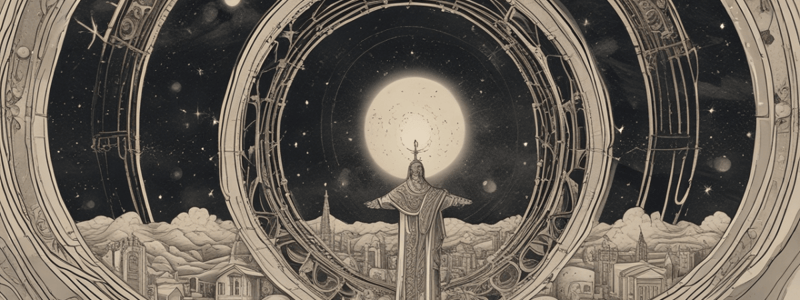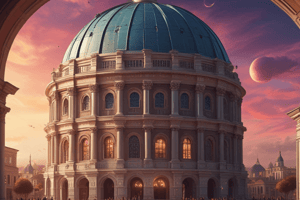Podcast
Questions and Answers
What did Galileo's findings reveal about the moon?
What did Galileo's findings reveal about the moon?
- It was pocked with craters and mountains (correct)
- It was a perfect celestial orb
- It was a star
- It was a new planet
What was significant about Galileo's publication 'The Starry Messenger'?
What was significant about Galileo's publication 'The Starry Messenger'?
- It was the first scientific paper ever published (correct)
- It was the first book to describe the heliocentric model
- It was written by the Pope
- It was a novel about the universe
Why did Galileo get into trouble with the Church in 1614?
Why did Galileo get into trouble with the Church in 1614?
- He spoke out against the Pope
- He discovered a new planet
- He supported the geocentric model
- He supported the heliocentric model (correct)
What was the outcome of Galileo's trial in 1633?
What was the outcome of Galileo's trial in 1633?
What was the significance of the Milky Way in Galileo's observations?
What was the significance of the Milky Way in Galileo's observations?
What was the title of Galileo's book that got him into trouble with the Pope?
What was the title of Galileo's book that got him into trouble with the Pope?
Why did Galileo include geocentric arguments in his book?
Why did Galileo include geocentric arguments in his book?
What was the name of the character Galileo used to present the geocentric arguments in his book?
What was the name of the character Galileo used to present the geocentric arguments in his book?
What was the outcome of Galileo's meeting with the Pope in 1623?
What was the outcome of Galileo's meeting with the Pope in 1623?
What was Galileo's response to the Church's warnings?
What was Galileo's response to the Church's warnings?
Flashcards are hidden until you start studying
Study Notes
The Copernicus Crisis
- In the 17th century, the Catholic Church faced a crisis with the rise of Protestant Reformation and the emergence of heliocentrism, which challenged the geocentric model of the universe.
Heliocentrism and the Church
- Heliocentrism, which placed the sun at the center of the universe, was popularized by Copernicus in 1543.
- The Church tried to suppress heliocentrism, but it gained popularity, especially among Protestant scientists like Johannes Kepler and Tycho Brahe.
Galileo's Contributions
- Galileo conducted experiments to prove heliocentrism, including his famous Falling Bodies Experiment.
- He demonstrated that the weight of an object does not affect its falling speed, contradicting the common sense notion that heavy objects fall faster.
The Importance of the Scientific Method
- Galileo's experiment was significant because it isolated the factor of weight and tested it, unlike simple observations.
- He understood the limitations of human observation and developed a new approach to science, which required experimentation and proof.
Galileo's Telescope and Observations
- Galileo built his own telescope in 1609, improving its power and overcoming human observation limitations.
- With his telescope, Galileo observed the heavens, discovering four moons of Jupiter, the phases of Venus, and the imperfections of the moon.
- His observations proved the heliocentric model and refuted the geocentric model.
The Church's Response
- Galileo's findings angered the Pope, and he was eventually put on trial for heresy.
- Although initially cleared, Galileo was later placed under house arrest for publishing a book that defended heliocentrism and mocked geocentrism.
Studying That Suits You
Use AI to generate personalized quizzes and flashcards to suit your learning preferences.




